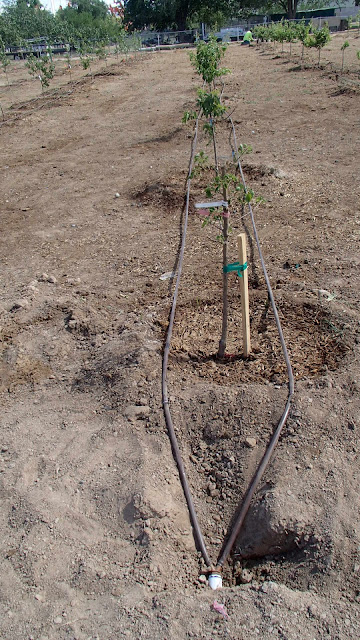 |
| Cart paths bordering the block of two-year-old fruit trees at Ahern Orchard |
 |
| A cart path through the One-year-old plum and plot block of fruit trees at the air Ahern orchard |
There is a new Orchard about 1 ½ miles from Las Vegas Blvd., in Las Vegas Nevada and located in the Mojave Desert. It has been called “historic” by some because there is nothing like it anywhere in the United States.
The Ahern Orchard
currently has a mixture of about 1600 fruit trees and 400 grapevines, both
table and wine grapes. It will expand to over 3000 plants in 2018 after spring
planting. It sits on private property, owned by Ahern Rentals, Inc. and fed
water from two agricultural wells that have been in existence for decades.
The area where it’s located
is historic as well, rich in pre-Las Vegas and Las Vegas history. The land was
formerly horse and residential property. Before the 1960s, there were artesian springs
in the vicinity where the Ahern Orchard is located.
 |
| In-line drip tubing used for irrigating fruit trees in the rows |
I have been working as a
consultant on this Orchard since it’s beginning starting February, 2016, with Lloyd
Benson, a VP of Ahern, who is the visionary behind this Orchard.
 |
| Irrigation valve, filter, pressure regulator and flow indicator (Ecoriser) for a block of fruit trees using in-line drip irrigation tubing |
Fruit trees on the
property include traditional peaches, nectarines, plums, apricots, apples, European
and Asian Pears, figs, pomegranates, pistachios, quince, persimmons and jujube.
Not so traditional are the interspecific and inter-generic hybrid fruit trees as
well including pluots, plumcots, apriums and others. Complicating this mixture
are over 80 varieties that spans a production season from mid-May to the end of
December.
The layout of the Orchard
is with tree spacings 10 feet apart in rows with spacing between rows
alternating between ten and 14 feet to accommodate management of fruit tree
operations. Trees will be managed to a maximum height of 10 feet. Covering the surface
of the soil in the rows are woodchips from local arborists, diverting this rich
resource from landfills to beneficial use.
Trees were planted bareroot
using a mixture of about 25% compost from Viragrow, Inc. and triple super
phosphate (0-45-0). First year trees were painted with whitewash to protect
them from sunburn. Many of the second-year trees were protected from sunburn
using white, plastic tree guards.
Grapevines are supported
by either single or double high tension steel cordon wires together with “catch
wires” to protect the fruit from sunburn. End posts and line posts are traditional
vineyard posts.
All fruit trees are drip
irrigated using in-line drip irrigation tubing down tree rows on both sides of
the trees. PVC headers and footers are located at the beginning and end of each
row that connect all of the in-line drip irrigation tubing in a “closed loop”. This
type of irrigation irrigates the entire row while keeping the spaces between
rows dry. Fruit tree roots will “follow the water” and eventually spread their
roots throughout the entire row.
Grapevines are irrigated
more traditionally with drip irrigation emitters, one on each side of a vine, with
water supplied from polyethylene tubing.
Currently we are involved
with winter fruit tree pruning at the Ahern Orchard. Some grape pruning will be
done now but “fine-tuning” the grapes with their final pruning will not occur
until February.












